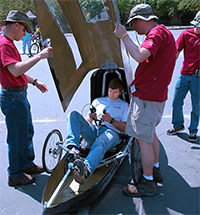Campus hosts human powered vehicle contest
By REBECCA MARTIN
Fresno State hosted its first Human-Powered Vehicle Challenge held over the weekend.

Chico State team members prepare to take their nearly $4,000 human-powered vehicle for a practice lap. The team won the three-wheel vehicle challenge. Photo by Joseph Hollak |
The event, which pitted different schools’ teams against one another, included more than 200 mechanical engineering students competing to build an efficient mode of transportation. There were three different categories for students to compete in during the event: endurance, sprint and utility.
Fresno State finished second in the utility race and sixth in the sprint race.
Cal Poly, San Luis Obispo won the overall single-rider competition. Seattle Univer-sity won the overall utility bike competition, and the University of Nevada-Las Vegas was the only team to finish the multi-rider competition.
Chico State won the endurance race. Central Washington University won the utility race and Cal Poly won the sprint race.
The sprint event began Saturday morning at 8 a.m. Participants raced a quarter of a mile on Barstow Avenue between Willow and Chestnut avenues northeast of campus. The Saturday morning race determined the starting order of Sunday’s endurance race.
The utility race is different from the other two races, which emphasize speed instead of the build of the vehicle. Students, when constructing the utility vehicle, had to build a vehicle designed to replace a car as transportation. Require-ments included being able to carry cargo, stopping at a stop sign during the race and going over a ramp.
The endurance race emphasized the velocity and durability of the vehicle under pressure. The event is about 25 miles long.
The race is organized like a relay, with several students from each team taking turns racing the vehicle for a period of time. The rules of the competition require at least one of the racing team members to be female.
This year’s Fresno State utility team consisted almost entirely of students new to the competition, with the exception of Nicole O’Kelley.
Physical fitness was a key to success in the races, said Maria Sanchez, the adviser to the Fresno State team.
“They were supposed to work out,” Sanchez said. “It’s both design and endurance.”
Schools can participate in all three of the competitions or just one.
Participants in the races came from as far away as Montana, Hawaii, Seattle, Denver and South Dakota.
Students from the South Dakota School of Mines and Technology, who participated in the utility race Saturday afternoon, traveled more than 26 hours by car to participate in the event, student D.J. Kjar said.
The school has been participating in the American Society of Mechanical Engineering event since 1999.
The competition ended for the South Dakota team when its vehicle fell over while making a sharp turn.
Students and faculty from the school raced to the crash site but soon realized there was no hope of fixing the vehicle.
Teams are given 20 minutes to fix their vehicles after a crash and prove to judges the vehicle is structurally sound and can continue the competition.
Last year’s event was held in Oregon. Fresno State students worked this year to gain sponsors to help build their vehicle, since the cost to build one can range anywhere from $1,000-$5,000, the Fresno State team said.
|
